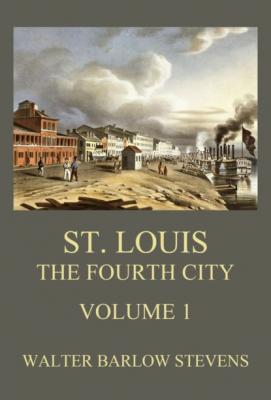St. Louis - The Fourth City, Volume 1. Walter Barlow Stevens
Читать онлайн.| Название | St. Louis - The Fourth City, Volume 1 |
|---|---|
| Автор произведения | Walter Barlow Stevens |
| Жанр | Документальная литература |
| Серия | |
| Издательство | Документальная литература |
| Год выпуска | 0 |
| isbn | 9783849659301 |
St. Louis – The Fourth City
1764 – 1911
Volume 1
WALTER BARLOW STEVENS
St. Louis, The Fourth City, Vol. 1, Walter Barlow Stevens
Jazzybee Verlag Jürgen Beck
86450 Altenmünster, Loschberg 9
Deutschland
ISBN: 9783849659301
www.jazzybee-verlag.de
CONTENTS:
CHAPTER II. PERMANENCE 1764-1770. 18
CHAPTER III. THE SPANISH GOVERNORS. 50
CHAPTER IV. WHEN ST. LOUIS WAS A TOWN... 72
CHAPTER V. THE MUNICIPALITY.. 94
CHAPTER VI. THE FUR TRADERS. 132
CHAPTER VIII. THE MINING INDUSTRIES. 214
CHAPTER IX. BANKERS AND BANKS. 241
CHAPTER X. STEAMBOAT DAYS. 287
CHAPTER XI. OUR INDIAN RELATIONS. 319
CHAPTER XII. ST. LOUIS, THE GATEWAY.. 341
CHAPTER XIII. WHEN ST. LOUISANS RODE.. 357
CHAPTER XIV. THE ERA OF RAILS. 387
CHAPTER XV. LAWYERS AND COURTS. 407
CHAPTER XVI. GREAT DAYS OF ST. LOUIS. 447
THE MOTIVE
This is not a book of dates. It does not abound in statistics. It avoids controversies of the past and prophecies of the future. The motive is to present in plain, newspaper style a narrative of the rise and progress of St. Louis to the fourth place among American cities. To personal factors rather than to general causes is credited the high position which the community has attained. Men and women, more than location and events, have made St. Louis the Fourth City.
The site chosen was fortunate. Of much greater import was the character of those who came to settle. American history, as told from the Atlantic seaboard points of view, classed St. Louis as "a little trading post." The settlement of Laclede was planned for permanence. It established stable government by consent of the governed. It embodied the homestead principle in a land system. It developed the American spirit while "good old colony times" prevailed along the Atlantic coast. Home rule found in St. Louis its first habitat on this continent.
Living under Spanish sovereignty in mildest form, these republican Frenchmen supplied lead for Washington's armies. They extended sympathy and substantial aid to George Rogers Clark. They performed no inconsiderable part in the saving of the Mississippi Valley, east of the river, to the American republic. They helped materially to make the Great Lakes the British boundary. They were ready for the peaceful transfer of authority at St. Louis to the United States, March 10, 1804. They responded with patriotic enthusiasm and with courageous effect when the second break with England came in 1812, campaigning with William Henry Harrison.
In the winning of the west there is no more stirring story than that which follows the growing column of immigration across the Mississippi, at St. Louis, after Amos Stoddard raised the flag of the United States. St. Louis had a population of about 1,000 when the acquisition went into effect. Beyond were wilds in undisputed possession of Indians and "varmints" except for the fur traders' posts along the Missouri. But such was the incoming of settlers that in eight years the government at Washington recognized Upper Louisiana as a political territory, established a capital at St. Louis and organized five counties with a legislature. And six years later this territory, growing as have few other subdivisions of the United States, was asking the statehood, which was granted in 1821 to 70,647 people.
In the forty years preceding the Civil war, St. Louis was the gateway to the west; was on the debatable border between the north and the south. The city grew in population, in trade relations, in wealth, while the irrepressible issue of slavery hung, a darkening cloud, overhead. Strong individualities matured in that period — St. Louisans who are to be taken into account in national as well as in local history.
Flood, fire and pestilence together failed to check the progress of this indomitable community. During the decade when the city passed through these visitations the phenomenal percentage of growth was made.
In 1861 St. Louis put the seal of disapproval upon disunion. Out of a few days of political chaos, in which the pavements were spattered with the blood of citizens, the community emerged with law and order asserted and with civil government fully restored, not by outside force, but through the inherent, instinctive regard of the people. The record of St. Louis for 1861-5 is a monument. Here centered the ghastly horrors of war. Here was carried through by St. Louisans, on their own initiative and by their own efforts, the work of mitigation of those horrors.
The last third of the century brought the supreme test of the fiber of St. Louisans. The city had waxed great and opulent on waterway transportation. The in hoc signo on the municipal seal was a steamboat. The age of the locomotive matured. In two decades rails took the place of rivers. No other American city has been called upon to adapt itself so quickly to such radical changes in business, in industrial life. St. Louis marked time, caught the cadence of the shriller whistle and moved on with added prestige.
From the beginning the settlement developed distinctive character. St. Louis came to possess traits which helped it to outstrip other cities. Here, through the generations, elements of population have been blending. They have produced a people who have exerted far reaching influence and who have performed no insignificant part in the making of the American nation. In the commingling of these elements has been wrought the evolution of the
